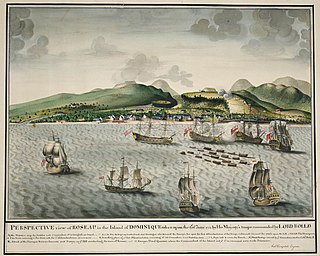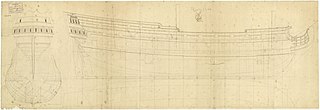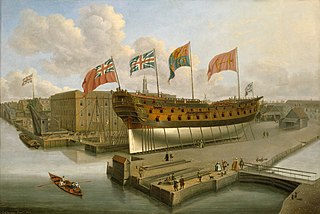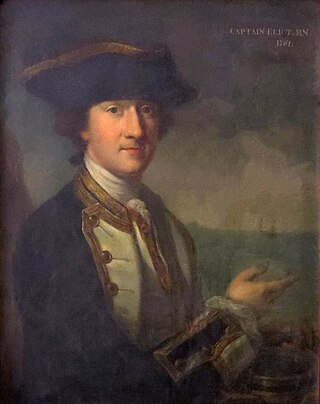
Admiral Sir William Cornwallis, was a Royal Navy officer. He was the brother of Charles Cornwallis, 1st Marquess Cornwallis, British commander at the siege of Yorktown. Cornwallis took part in a number of decisive battles including the siege of Louisbourg in 1758, when he was 14, and the Battle of the Saintes but is best known as a friend of Lord Nelson and as the commander-in-chief of the Channel Fleet during the Napoleonic Wars. He is depicted in the Horatio Hornblower novel, Hornblower and the Hotspur.

HMS Berwick was a 74-gun Elizabeth-class third rate of the Royal Navy, launched at Portsmouth Dockyard on 18 April 1775, to a design by Sir Thomas Slade. She fought the French at the Battle of Ushant (1778) and the Dutch at the Battle of Dogger Bank (1781). The French captured her in the action of 8 March 1795 during the French Revolutionary Wars and she served with them with some success then and at the start of the Napoleonic Wars until the British recaptured her at the Battle of Trafalgar. Berwick sank shortly thereafter in a storm.

The Dublin-class ships of the line were a class of seven 74-gun third rates, designed for the Royal Navy by Sir Thomas Slade.

HMS Dublin was a 74-gun third rate ship of the line of the Royal Navy, built by Adam Hayes at Deptford Dockyard and launched on 6 May 1757.

Vice-Admiral Sir Joshua Rowley, 1st Baronet was a Royal Navy officer who was the fourth son of Admiral Sir William Rowley. Sir Joshua was from an ancient English family, originating in Staffordshire (England) and was born on 1 May 1734. Rowley served with distinction in a number of battles throughout his career and was highly praised by his contemporaries. Unfortunately whilst his career was often active he did not have the opportunity to command any significant engagements and always followed rather than led. His achievements have therefore been eclipsed by his contemporaries such as Keppel, Hawke, Howe and Rodney. Rowley however remains one of the stalwart commanders of the wooden walls that kept Britain safe for so long.

HMS Brunswick was a 74-gun third rate ship-of-the-line of the Royal Navy, launched on 30 April 1790 at Deptford. She was first commissioned in the following month under Sir Hyde Parker for the Spanish Armament but was not called into action. When the Russian Armament was resolved without conflict in August 1791, Brunswick took up service as a guardship in Portsmouth Harbour. She joined Richard Howe's Channel Fleet at the outbreak of the French Revolutionary War and was present at the battle on Glorious First of June where she fought a hard action against the French 74-gun Vengeur du Peuple. Brunswick was in a small squadron under William Cornwallis that encountered a large French fleet in June 1795. The British ships successfully retreated into the Atlantic through a combination of good seamanship, good fortune and deceiving the enemy.

Centaure was a 74-gun ship of the line of the French Navy, launched at Toulon in 1757. She was designed by Joseph-Marie-Blaise Coulomb and named on 25 October 1755, and built under his supervision at Toulon. In French service she carried 74 cannon, comprising: 28 x 36-pounders on the lower deck, 30 x 18-pounders on the upper deck, 10 x 8-pounders on the quarterdeck, 6 x 8-pounders on the forecastle.

President was a 38-gun fourth rate frigate of the Royal Navy, originally built for the navy of the Commonwealth of England by Peter Pett I at Deptford Dockyard, and launched in 1650.
HMS Greenwich was a 50-gun fourth rate ship of the line of the Royal Navy. She was built during the War of the Austrian Succession, and went on to see action in the Seven Years' War, during which she was captured by the French and taken into their service under the same name. She was wrecked shortly afterwards.

HMS Essex was a 70-gun third rate built by Sir Henry Johnson of Blackwall in 1678/79. During the War of the English Succession she fought in the last major action. She was rebuilt in 1699/1700. During the War of Spanish Succession she fought at Vigo Bay, the Capture of Gibraltar and Velez Malaga. She also fought at the Battle off Passero in 1718. She was rebuilt again in 1736-40. She was in action off Toulon in 1744. She was active in the Channel and against French ports during the Seven Years War. She fought at Quiberon Bay in 1759. She was wrecked in Quiberon Bay in November 1759.

HMS Kingston was a 60-gun fourth-rate ship of the line of the Royal Navy, built by Frame in Hull and launched on 13 March 1697. She had an eventful career, taking part in numerous engagements.

HMS Buckingham was a 70-gun third-rate ship of the line of the Royal Navy, built at Deptford Dockyard by John Holland to the draught specified by the 1745 Establishment, and in active service during the Seven Years' War with France. With a crew of 520 she was one of the largest ships in the Navy at that time.

HMS Dorsetshire was a 70-gun third-rate ship of the line of the Royal Navy, built at Chatham Dockyard to the draught specified by the 1745 Establishment, amended in 1754, and launched on 13 December 1757.

John Eliot was a Royal Navy captain. He was appointed Governor of West Florida in 1767 and committed suicide in 1769, shortly after his arrival in Pensacola.

The Battle of Cap-Français was a naval engagement during the Seven Years' War fought between French and British forces outside the harbour of Cap-Français, Saint-Domingue on 21 October 1757.

Arthur Forrest was a British officer of the Royal Navy who saw service during the War of the Austrian Succession and the Seven Years' War, rising to the rank of captain and the post of commodore. He also owned 3,000 acres of sugar plantations, and a considerable number of slaves, in the Colony of Jamaica.

Vice-Admiral Thomas Cotes was a Royal Navy officer who became Commander-in-Chief of the Jamaica Station.

Henrik Gerner (1742–1787) was a Danish naval officer who specialised in shipbuilding and naval architecture. His interests as an entrepreneurial engineer led to unsinkable gun platforms, horse-driven dredging machines, and desalination equipment for Orient-bound trading ships.
Andreas Gerner was a Danish naval officer who was also employed in the building of ships for the Royal Dano-Norwegian Navy.

















